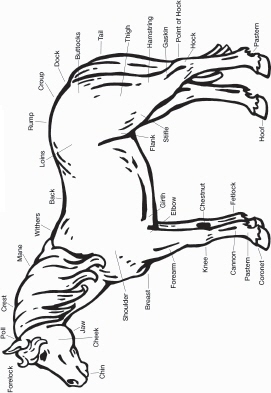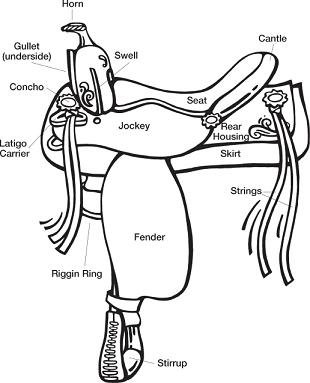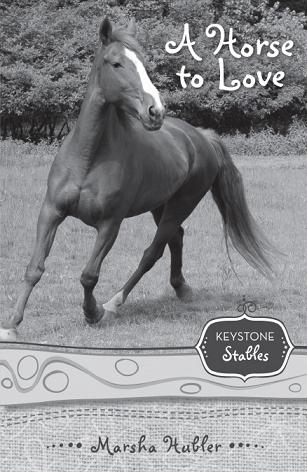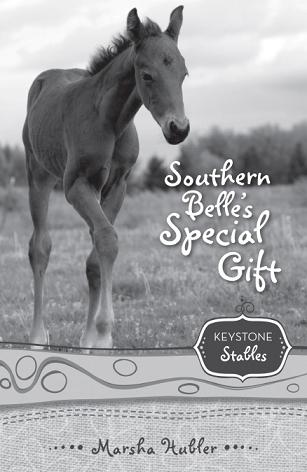On the Victory Trail (16 page)

A Word about Horse Whispering
If you are constantly reading about horses and know a lot about them, you probably have heard of horse whisper-ing, something that many horse behaviorists do today to train horses. This training process is much different than what the majority of horsemen did several decades ago.
We've all read Wild West stories or seen movies in which the cowpoke “broke” a wild horse by climbing on his back and hanging on while the poor horse bucked until he was so exhausted he could hardly stand. What that type of training did was break the horse's spirit, and the horse learned to obey out of fear. Many “bronco busters” from the past also used whips, ropes, sharp spurs, and painful bits to make the horses respond, which they did only to avoid the pain the trainers caused.
Thankfully, the way many horses become reliable mounts has changed dramatically. Today many horses are trained, not broken. The trainer “communicates” with the horse using herd language. Thus, the horse bonds with his trainer quickly, looks to that person as his herd leader, and is ready to obey every command.
Thanks to Monty Roberts, the “man who listens to horses,” and other professional horse whispering trainers like him, most raw or green horses (those that are just learning to respond to tack and a rider) are no longer broken.
Horses are now trained to accept the tack and rider in a short time with proven methods of horse whispering. Usually working in a round pen, the trainer begins by making large movements and noise as a predator would, encouraging the horse to run away. The trainer then gives the horse the choice to flee or bond. Through body language, the trainer asks the horse, “Will you choose me to be your herd leader and follow me?”
Often the horse responds with predictable herd behavior by twitching an ear toward his trainer then by lowering his head and licking to display an element of trust. The trainer mocks the horse's passive body language, turns his back on the horse, and, without eye contact, invites him to come closer. The bonding occurs when the horse chooses to be with the human and walks toward the trainer, thus accepting his leadership and protection.
Horse whispering has become one of the most accept-able, reliable, and humane ways to train horses. Today we have multitudes of rider-and-horse teams that have bonded in such a special way, both the rider and the horse enjoy each other's company. So when you're talking to your friends about horses, always remember to say the horses have been trained, not broken. The word
broken
is part of the horse's past and should remain there forever.
Bible Verses about Horses
Do you know there are about 150 verses in the Bible that include the word
horse
? It seems to me that if God mentioned horses so many times in the Bible, then he is very fond of one of his most beautiful creatures.
Some special verses about horses in the Bible make any horse lover want to shout. Look at this exciting pas-sage from the book of Revelation that tells us about a wonderful time in the future:
“I saw heaven standing open and there before me was a white horse, whose rider is called Faithful and True. With justice he judges and makes war. His eyes are like blazing fire, and on his head are many crowns. He has a name written on him that no one knows but he himself. He is dressed in a robe dipped in blood, and his name is the Word of God. The armies of heaven were following him riding on white horses and dressed in fine linen, white and clean” (Revelation 19:11 â 14).
The rider who is faithful and true is the Lord Jesus Christ. The armies of heaven on white horses who follow Jesus are those who have accepted him as their Lord and Savior. I've accepted Christ, so I know that some day I'll get to ride a white horse in heaven. Do you think he will be a Lipizzaner, an Andalusian, or an Arabian? Maybe it will be a special new breed of white horses that God is preparing just for that special time.
Perhaps you never realized that there are horses in heaven. Perhaps you never thought about how you could go to heaven when you die. You can try to be as good as gold, but the Bible says that to go to heaven, you must ask Jesus to forgive your sins. Verses to think about: “For all have sinned and fall short of the glory of God” (Romans 3:23); “For God so loved the world that he gave his one and only son, that whoever believes in him shall not perish but have eternal life (John 3:16); “For everyone who calls on the name of the Lord will be saved” (Romans 10:13).
Do you want to be part of Jesus' cavalry in heaven some day? Have you ever asked Jesus to forgive your sins and make you ready for heaven? If you've never done so, please ask Jesus to save your soul today.
As I'm riding my prancing white steed with his long wavy mane and tail dragging to the ground, I'll be look-ing for you!
Gait
â A gait is the manner of movement; the way a horse goes.
There are four natural or major gaits most horses use:
walk, trot, canter, and gallop.
Walk
â In the walk, the slowest gait, hooves strike the ground in a four-beat order: right hind hoof, right fore (or front) hoof, left hind hoof, left fore hoof.
Trot
â In the trot, hooves strike the ground in diagonals in a one-two beat: right hind and left forefeet together, left hind and right forefeet together.
Canter
â The canter is a three-beat gait containing an instant during which all four hooves are off the ground. The foreleg that lands last is called the
lead
leg and seems to point in the direction of the canter.
Gallop
â The gallop is the fastest gait. If fast enough, it's a four-beat gait, with each hoof landing separately: right hind hoof, left hind hoof just before right fore hoof, left fore hoof.
Other gaits come naturally to certain breeds or are developed
through careful breeding.
Running walk
â This smooth gait comes naturally to the Tennessee walking horse. The horse glides between a walk and a trot.
Pace
â A two-beat gait, similar to a trot. But instead of legs pairing in diagonals as in the trot, fore and hind legs on one side move together, giving a swaying action.
Slow gait
â Four beats, but with swaying from side to side and a prancing effect. The slow gait is one of the gaits used by five-gaited saddle horses. Some call this pace the
stepping pace
or
amble
.
Amble
â A slow, easy gait, much like the pace.
Rack
â One of the five gaits of the five-gaited American saddle horse, it's a fancy, fast walk. This four-beat gait is faster than the trot and is very hard on the horse.
Jog
â A jog is a slow trot, sometimes called a
dogtrot.
Lope
â A slow, easygoing canter, usually referring to a western gait on a horse ridden with loose reins.
Fox trot
â An easy gait of short steps in which the horse basically walks in front and trots behind. It's a smooth gait, great for long-distance riding and characteristic of the Missouri fox trotter.
Parts of a Horse

The Western Saddle

Resources for Horse Information
Contained in this Book
Henry, Marguerite.
Album of Horses.
Chicago: Rand McNally
& Co., 1952.
Henry, Marguerite.
All About Horses.
New York: Random
House, 1967.
Jeffery, Laura.
Horses
:
How to Chose and Care for a Horse
.
Berkley Heights, NJ: Enslow Publishers, Inc., 2004.
Roberts, Monty.
The Horses in My Life
. Pomfret, VT: Trafalgar
Square Publishers, North, 2004.
Self, Margaret Cabell.
How to Buy the Right Horse
. Omaha,
NE: The Farnam Horse Library, 1971.
Simon, Seymour.
Horses
. New York: HarperCollins, 2006.
Sutton, Felix.
Horses of America.
New York: G.P. Putnam's
Sons, New York City, 1964.
Ulmer, Mike.
H is for Horse
:
An Equestrian Alphabet
. Chelsea,
MI: Sleeping Bear Press, 2004.
Online resources
http://www.appaloosayouth.com/index.html
http://www.shetlandminiature.com/kids.asp
http://www.twhbea.com/youth/youthHome.aspx

Book 1: A Horse to Love
By Marsha Hubler
Softcover ISBN 978-0-310-71792-8
ISBN 978-0-310-71792-8
Meet Skye, a troubled foster girl, sent to live with Christian foster parents who intro-duce her to the wonderful world of horses. At Keystone Stables, a special-needs dude ranch in central Pennsylvania, Skye meets Champ, a champion sorrel quarter horse who helps her accept God's unconditional forgiveness and love. Previously titled as
The Trouble with Skye.
Available now at your local bookstore!


